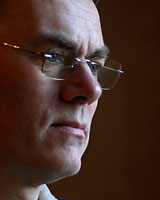King Lear Act 1 by Brother Blue. There are more ways of telling a story than simply sticking to the script. Personal stories as told by Brother Blue interpreted the story using characters from his own family. It engaged us - we learned as much about Brother Blue's family as we did King Lear's through this very personal storytelling. He put himself into it. This was just one of the clips of video he used to illustrate his talk amount the emotional and personal investment that makes stories come alive.
So the day began with Kevin Brooks' keynote "speech".
Returning the hire car had been the first job of the day. I'll miss having it. The car is essential for getting around here. These towns are designed for car drivers. Few people walk. One of the conference delegates tells me that it's too hot to walk in summer and too cold in winter. The car provides a temperature controlled environment to protect Americans from the extreems of their climate as they travel down the street to the store or amenity centre.
I'll also miss the wide open roads and country music playing on the car stereo. It sounds corny - but felt good - at least for the couple of days we had the car. The clerk at the car hire centre drove us to the college in time for the 8.30 start.
Dana Atchley's widow, Denise, opens the day with a welcome before introducing Kevin Brooks.
Six more speakers and a breakout session lay ahead before a barbeque dinner this evening. Some would provoke strong reactions in us, others would inspire. Some would do both at the same time. That was my experience with the next speaker, Megan Hayward of the University of Technology in Sydney, Australia. Non linear narratives, illustrated by an interactive CD ROM story "Of Day of Night". It's about a woman's road back to dreaming. Soemhow there was no conclusion to the story because of it's circular nature. But as Megan spoke I saw new possibilities. Could this process she'd used to create the CD be used in the process of discovering our own stories before they are written in a more engaging linear narative?
Our memories are fragments, our dreams are collisions of these fragments. Could the dreaming process be arrested in a piece od software and used creatively by randomly bringing fragments of memory together? Could a piece of software allow us to input those fragments of our histories and then replay them in a new order with collisions that create stories by resurrecting other more deeply hidden events and experiences from our memories? Using objects - things collected or discarded - and recording the story as the memory of it is prompted by these otherwise inconsequential items. In Megan's story the histories are fictional - but why should they not be more real, rooted in our own life stories. Although still affected by the faults of memory could those histories be revived with a freshness that comes from realisation and new possibilities to explain who we are and what we've experienced?
Model: Move around your space. Select objects, items, photos, letters, documents - go out and gather other triggers - places, people, on camera or video. Borrow other items from relatives and friends workplaces and the places you relax. Input or create a story for each prompt. What was, might have been, what happened, by whom, context, people, places consequences etc. Initiate random sequences and create collisions between those memories and as a result input new stories inspired by the process. Build the connections between the stories to create journeys and progressions. Disappointments, successes, limbos, epiphanies etc.
The result - a reconstruction of some of the black holes in our stories - the basis for stories more revealing and fresher than the anecdotes tripped out at every reunion or family gathering or story telling event. A more satifying outcome - using the techniques of non linear narative to provoke a traditionally contructed story.
After the talk I was given a sample of a piece of software that may achieve what I'd asked in my question to Megan. The software is called "Telling Stories" - Seth Socolow gave it to me. It's PC based so I'll have to wait to try it out.

